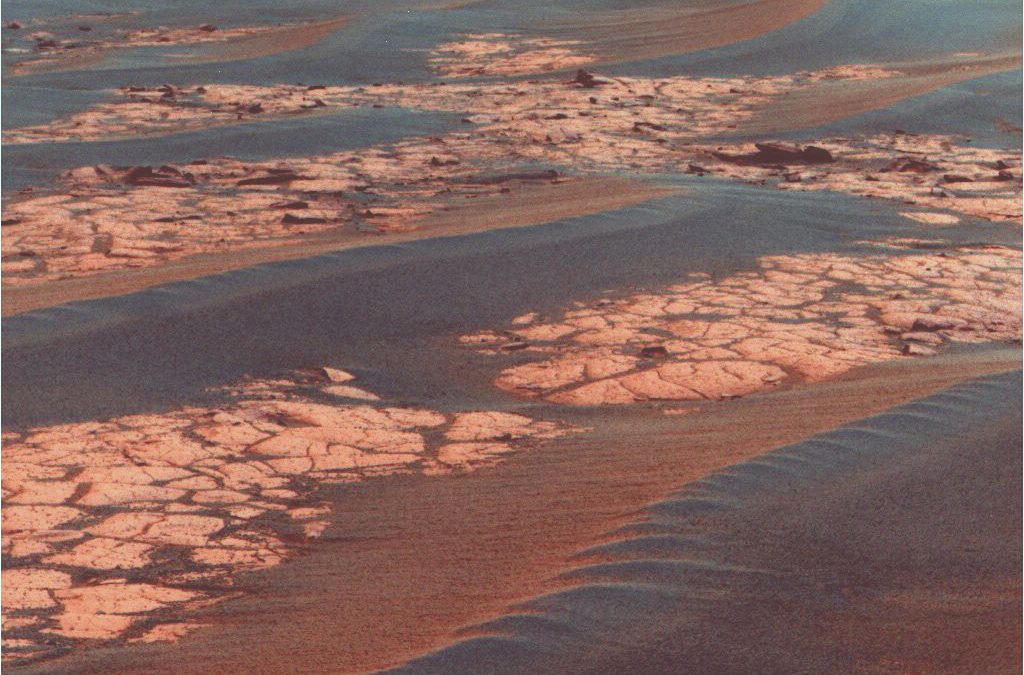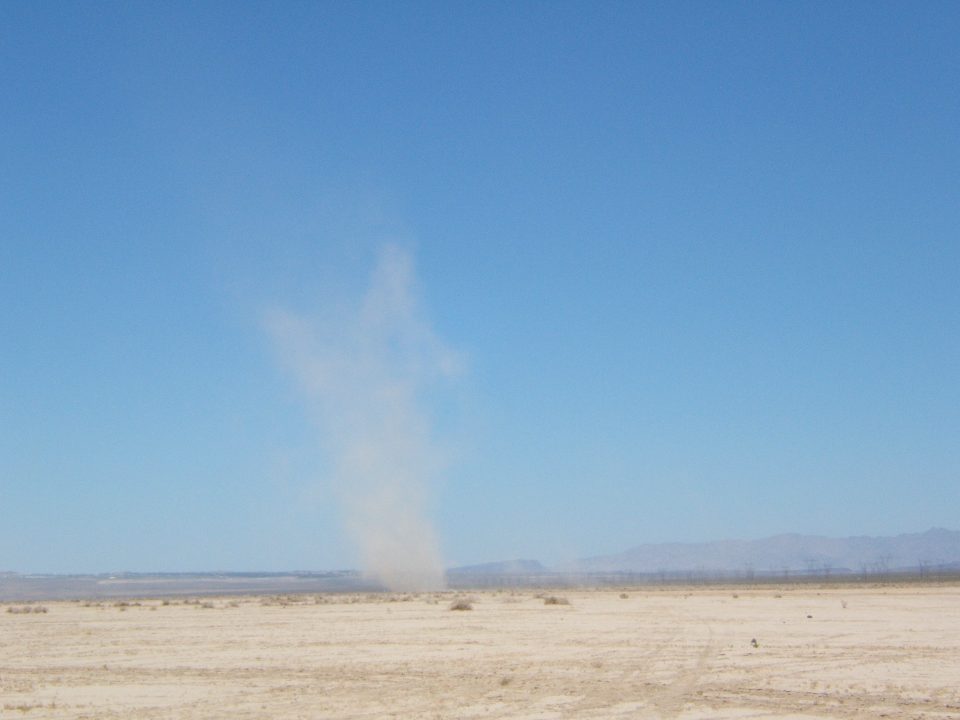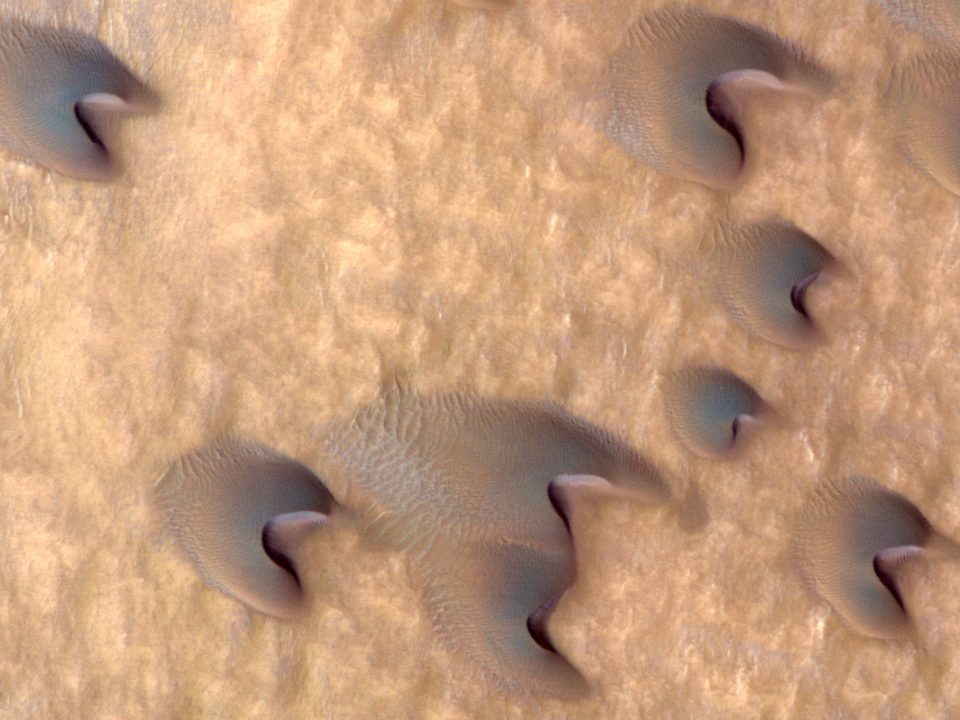My 2018 paper on recent climate change in Meridiani Planum, Mars (Part 3)

My 2018 Paper on Recent Climate Change in Meridiani Planum, Mars (Part 2)
April 12, 2018
Flow. Lots of flow.
April 16, 2018This is the 3rd (and final) entry in a blog series describing a paper I recently published with colleagues in JGR Planets. Here are links to the previous two entries: Part 1, Part 2.
Wow, I didn’t think this would take 3 entries. Science is weird. You start a project feeling out of your depth, not knowing exactly where it will take you. You stumble around, read a bunch of papers to absorb the wisdom of others, and work up the courage to do things. You struggle mightily in doing those things: making the model run, keeping access to the computer system, making sure the model output is what you think it is, figuring out what you need to calculate and the best way of doing so. And then a bunch of refining and reworking and throwing out old ideas and trying new things, sometimes based on precious conversations with colleagues who do their best to gently point out the idiotic mistakes you made (it’s okay because you’ve done the same for them too, once in a while). One of them is a high school student with so much promise that you’re torn between basking in their glow and throwing more work at them okay and maybe 1% of it is jealousy, but you’ve learned how to deal with that over the years – a lot of truly amazing people wind up doing this for a living so no matter how smart you are there will be someone else who’s smarter and/or more successful. You put forth ideas with them and they partially agree but have suggestions that make you want to scream because it will involve doing more things you hadn’t planned on doing, but you go and do those things because they’re right, and it will make the results stronger also you’re mid-career now so you’ve been through this enough that you no longer actually scream, you just take a deep breath and reassess your schedule to see who you’ll be pissing off next.
Eventually a result crystallizes: you’ve pulled some bit of knowledge, or at least potential knowledge, from all that scurrying about. Amidst the muck there’s this beautiful nugget that makes sense, and it’s so simple that you wonder why nobody figured it out before. But nobody has, so you write up that nugget into a “short” paper that turns out to have ten figures and two tables and is fifteen pages long – that’s more like an average paper than it is a short one and you realize that perhaps most of your other papers are too long. You find that when you sit down to try to explain it to people, it’s not quite as simple as you thought, and that it takes some effort to explain coherently. But you must try, because this is something people should know.
So where are we? Mars has a vast plain near both its equator and it prime meridian, called Meridiani Planum and you thought you didn’t speak Latin. Old, dormant ripples with crests aligned N-S cover most of that plain, formed >200,000 years ago by a strong easterly wind. Sometimes the wind becomes strong enough to reactivate them, and this last happened >50,000 years ago. At some point after that, a different set of winds reworked the crests to form smaller ripples with crests aligned NNE-SSW, but that wind also stopped blowing. Those ripples are a record of recent climate change on Mars, leftover bits made by things that used to happen that are different from things happening now.
Sensitivity tests using a Mars global climate model (MGCM) have shown that orbital and axial variations do indeed influence wind strengths and directions in Meridiani. Right now Mars’ obliquity (axial tilt) is about in the middle of the range it’s experienced over the past 400,000 years, and perihelion (when Mars is closest to the Sun, so it gets slightly stronger rays) occurs during southern hemisphere’s summer. This combination leads to relatively strong winds – the other sets of orbital and axial variations mostly produced weaker winds. But the ripples aren’t active today, and it looks like they couldn’t have been active under most other configurations Mars has experienced. What gives?
Well there’s one factor we haven’t yet accounted for: changing air pressure. We finally stuck a radar on a Mars orbiter, and found something big: a huge chunk of CO2 ice buried at the south pole. It’s thought that that ice got stuck there when Mars’ axial tilt dropped to near zero, which makes the poles cold enough to make the atmosphere itself condense on the surface (this still happens in winter on Mars, but not to the degree it used to). It makes sense that a thicker atmosphere would more easily push sand around, like a big bully pushing around little kids on a playground. A followup study showed that every time Mars’ tilt dropped, ice built up at the south pole and then got stuck there, eventually cutting the atmospheric pressure down to half of what it was it was half a million years ago.
So we ran 3 new MGCM cases, picking periods over the past 400,000 years when we’d expect wind to be strongest, which means 1) the air pressure was higher than today, 2) the obliquity was relatively high, and 3) the season of perihelion occurred during southern summer. Here’s a plot summarizing the results:
Check out all these things. Don’t panic: they all show the same time period on the horizontal axis. See? Easy. They plot changes in a) air pressure, b) obliquity (axial tilt), c) season of perihelion (~270 degrees is southern summer solstice),
d) orbital eccentricity, e) drift potential (i.e., windiness) relative to today, and f) the crest direction that ripples would form with. Diamonds show MGCM results, including today’s case (at time = 0) and at three periods in the past when the air pressure was high, the obliquity was high, and the season of perihelion happened during southern hemisphere summer.
OK, now we’re talking. The drift potential (DP) in these cases is now finally substantially higher than that today. From this we can propose that the ripples were last active, and possibly originally built, in a wind regime dating to one of these high air pressure periods. Maybe they were first formed in that big obliquity bump around 380,000 years ago – our MGCM simulation at 395,000 years ago suggests the winds could have moved more than 3x the amount of sand they can today.
Crater dating suggests the bigger N-S ripples last moved during some period between 50,000 and 200,000 years ago. They didn’t move a lot, but they did move some. And sometime after that (but not in the last 10 years), the wind pattern shifted and made smaller NNE-SSW ripples. We thought “hmm, let’s have a closer look at that most recent obliquity bump at about 100,000 years ago. That one falls in the right date range.” The air pressure then was 1.4 mbar higher than today (about 20% higher), and the drift potential was ~36% higher than today. That might be strong enough for some limited ripple activity.
So we ran a few more MGCM cases the last ones, I promise. Over the course of that recent obliquity bump (which peaked 94,000 years ago), the season of perihelion steadily changed. So we made sure we sampled the whole seasonal range, picking cases that occurred when the season corresponded with southern summer solstice, northern spring equinox, northern summer solstice, and southern spring equinox. We even ran a low dust scenario for the northern summer solstice case, because the atmospheric dust loading may be sensitive to perihelion season. Below is a plot, a lot like the one above, showing our results.
This is what the MGCM thinks would have happened in Meridiani Planum during the most recent obliquity bump at ~100,000 years ago, showing a) obliquity (axial tilt), b) season of perihelion, c) orbital eccentricity, d) drift potential (i.e., windiness) relative to today, and e) ripple crest directions those winds would produce.
What this plot shows is that during that last obliquity bump, the slightly elevated air pressure, obliquity, and season of perihelion from 86,000 to 111,000 years ago combined to produce a much winder environment (30-50% windier) than Merdiani Planum experiences today. As the obliquity started to drop, the windiness also dropped, so that the last case at 72,000 years ago was about as windy as Meridiani Planum is today (or perhaps a bit less, if a lower atmospheric dust content is accounted for).
This is consistent with what the ripples are telling us. So here’s what we propose happened:
- Sometime long ago, more than 200,000 years ago, big N-S plains ripples formed all over Meridiani Planum. Possibly because of a big obliquity peak at ~380,000 combined with an air pressure nearly double that of Mars’ today.
- When the air pressure was higher, the big ripples moved. They were probably most active when these periods coincided with high obliquity and periods when the season of perihelion occurred during southern hemisphere summer.
- The last time that set of events coincided was ~100,000 years ago, during Mars’ last obliquity peak (which by the way peaked at 26.7 degrees at 94,000 years ago, only 1.5 degrees more tilted than today which while small for Mars, it’s still half again as big as typical axial tilt variations on Earth. Texas is big but it’s nothing compared to Mars.)
- So the last westward migration of the bigger N-S ripples (known from crater dating to have occurred between 50,000 to 200,000 years ago) probably happened during that obliquity peak ~100,000 years ago.
- While the obliquity was waning, Mars’ orbit swung around so that perihelion occurred during northern summer. When perihelion occurs during northern summer, wind patterns shift (technical info: southeasterly Hadley return flow intensifies) so that any ripples made would be aligned NNE-SSW. Probably sometime in that period from 72,000 to 86,000 years, there was some combination of winds strong enough to make ripples that would also make them with crests aligned NNE-SSW. And that’s probably how the smaller ripples formed out of the crests of the bigger ones.
This level of consistency in planetary science is immensely gratifying. For once, a bunch of orbital observations, inferences drawn from a bunch of careful measurements from those observations, a bunch of careful modeling based on those inferences done to predict atmospheric behavior, and a bunch of inferences drawn from calculations on those model results made using untold (but hopefully justified) assumptions, combine to actually make sense.
It’s possible it’s all a happy accident. But maybe not: maybe it’s close to correct. What matters is that it both makes sense and is consistent with previous work. In 10 years, better data and better models and better assumptions will lead to better inferences, which will refine or perhaps overturn a result like this. That’s how science works and you get used to being proved wrong. But those refinements and potential overturnings might never happen if work like this isn’t done first. Papers like this can inspire model updates and new instruments for the next set of Mars orbiters assuming NASA actually gets around to planning another orbital mission.
If you got this far in reading, then you have my sincere gratitude for sticking it out. It means a lot that someone would try to understand my work. Next week I’ll get back to posting pretty and windy pictures of Mars.






